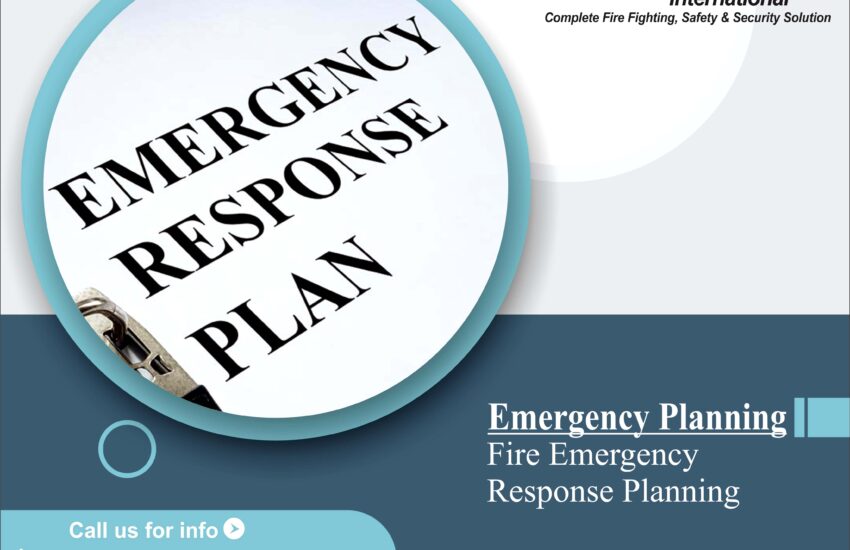Fire Emergency Response Planning No matter the size or type of your workplace, having a fire emergency response plan is essential. Emergencies can occur without warning, and having a well-prepared team can make the difference between a safe evacuation and a critical situation.
A clear, documented emergency response plan ensures that all staff members, contractors, and visitors know what actions to take if and when an emergency, such as a fire, occurs. This proactive planning reduces injuries, limits property damage, and minimizes operational downtime.
What Is an Emergency Response Plan?
An emergency response plan is a written, organized strategy outlining the actions employees must take during various emergency scenarios. This includes protocols for fire evacuation, contacting emergency services, managing hazards, and ensuring everyone’s safety.
It should be tailored to the specific risks within your workplace and reviewed regularly as operations or building layouts change.
How to Create an Effective Fire Emergency Response Plan
You can’t predict every possible incident, but these core steps will help you build a strong foundation for your plan:
1. Assess and Identify Safety Risks
Start by performing a thorough hazard and risk assessment to identify all fire-related and general safety risks in your environment. Consider:
- Historical incidents
- Current safety controls
- Physical layout of your premises
- Flammable materials or equipment
Document both existing and potential risks and use this assessment to inform your emergency planning process.
2. Develop a Strong Communication Plan
During an emergency, clear communication is critical. Your plan should:
- Identify who is responsible for directing communications
- Define how information will be relayed (e.g., phone, intercom, radios, mass text alerts)
- Ensure employees, visitors, and contractors are quickly and accurately informed
A well-developed communication plan allows for quick action, faster response from emergency services, and better coordination.
3. Highlight Potential Emergency Scenarios
When building your fire emergency response plan, highlight all potential fire-related emergencies. This includes:
- Electrical fires
- Kitchen or cafeteria fires
- Flammable chemical spills
- Fires in server rooms or mechanical areas
Use your company’s past incident records and industry data to anticipate and plan for these risks.
4. Training and Fire Drills
Once the plan is developed, train your staff regularly. This includes:
- Conducting fire drills at least twice a year
- Hands-on training for using fire extinguishers
- Clear instruction on evacuation procedures and roles
These exercises identify gaps in understanding and reinforce staff readiness in real-world scenarios.
Fire Emergency Response Planning: Key Actions to Include
Every fire emergency response plan should have a detailed fire evacuation procedure tailored to your workplace. Here’s what to include:
1. Raise the Alarm Immediately
Staff must understand how and when to raise the alarm if they discover a fire. Quick action minimizes delays and helps contain the situation.
2. Call the Fire Service
Once the alarm is raised, a designated team member must call the fire department immediately. Clearly outline who is responsible for making this call.
3. Stop Machinery and Isolate Power (If Safe)
If safe, trained personnel should stop machinery and isolate power sources to prevent escalation. Only designated individuals should perform these actions.
4. Evacuate the Premises
Everyone must evacuate the premises as soon as the alarm sounds unless otherwise instructed. Non-essential personnel should move quickly to the nearest exit, using designated escape routes.
5. Use Assembly Points
Pre-determined assembly points must be located at a safe distance from the building and preferably under cover. These areas are used for:
- Conducting roll calls
- Ensuring everyone has evacuated
- Coordinating with emergency services
6. Conduct Roll Calls
Each department should assign someone—such as a team leader or supervisor—to take a roll call at the assembly point. This confirms who is safe and identifies anyone potentially left behind.
7. Assign Fire Emergency Roles and Responsibilities
Appoint and train specific employees to handle fire-related tasks, such as:
- Acting as floor marshals
- Checking that rooms are clear
- Helping individuals with disabilities evacuate
- Securing the building if required
Final Thoughts: Stay Prepared and Stay Safe
Fire emergency response planning is not a one-time task—it’s an ongoing responsibility. By regularly updating your workplace fire safety procedures, training your team, and conducting drills, you can ensure that everyone knows what to do if a fire breaks out.


